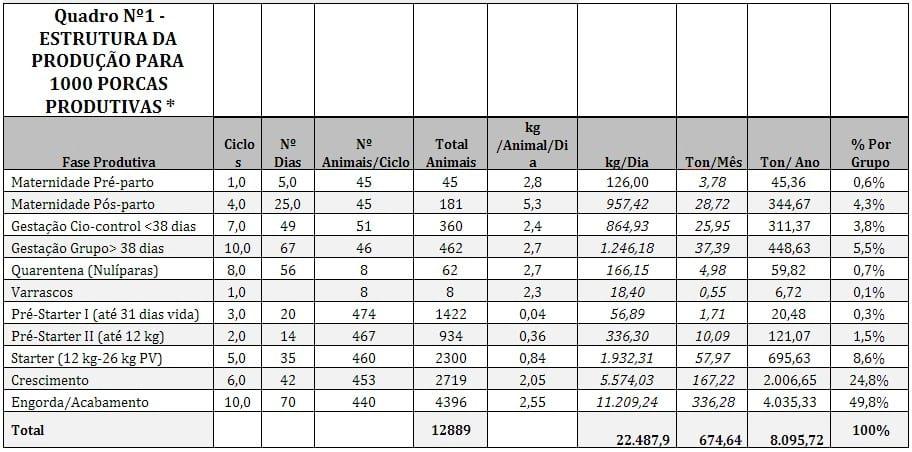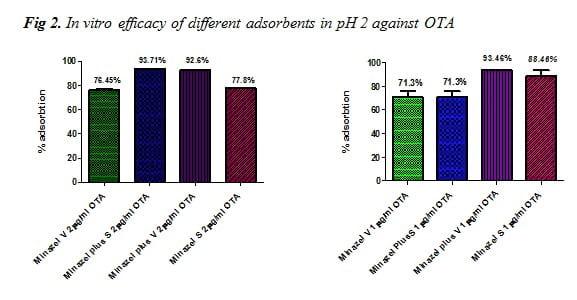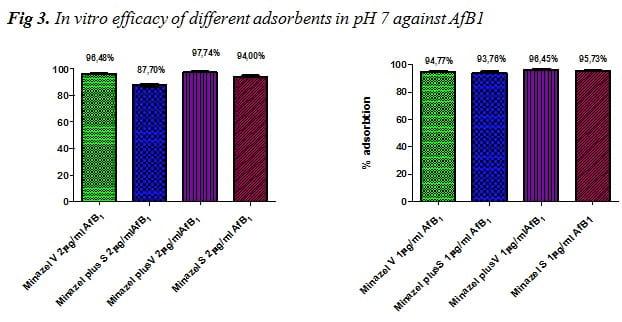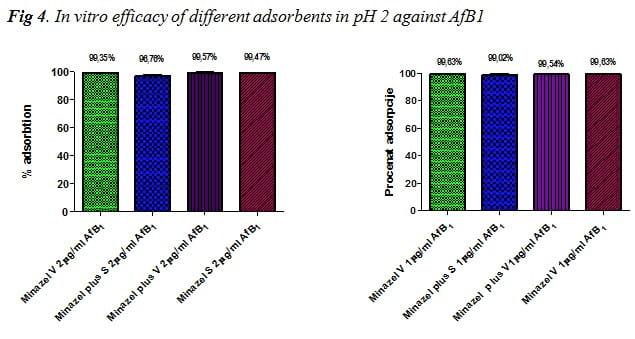Patent Co’s in vitro evaluation of Min-A-Zel and Min-A-Zel Plus efficacy in binding aflatoxin B1 and ochratoxin A
Published: May 19, 2015
By: Dr Jelena Nedeljkovic Trailovic (University of Belgrade, Serbia), Marko Vasiljevic, Jasna Bosnjak (2Patent co. private company from Serbia, producer of feed and feed additives)
Keywords: aflatoxin B1, ochratoxin A, E568, E567, zeolites organomodification
MYCOTOXINS are secondary toxic metabolites of saprophytic moulds and they enter organisms of humans and animals through food and feed. The first data about detrimental effects of mouldy food in China dates back to 3000 years B.C. Yellow rice toxin disease was recorded in Japan at the end of the XIX century, when people consumed mouldy rice. At the end of the XIX century and during the WWII Alimentary Toxic Aleukia (ATA) was recorded, caused by consumption of grains contaminated by Fusarium mould. 100,000 turkeys died in Great Britain in 1960. (turkey X desease) as peanut meal was contaminated with aflatoxin. This was a turning point in mycotoxin hystory, followed by intense research of mycotoxins and mycotoxicoses which lasts ever since.
MYCOTOXICOSES are diseases of humans and animals caused by mycotoxins. These deseases are not contagiuos, food or feed related to specific feeds. They can not be curred by antibiotics, nor they promote immune response in humans and animals. Mycotoxicoses occur seasonaly. Clinically, they often resemble diseases caused by patogenic microorganisms or nutrutive disbalances, therefore the diagnosis is challenging. Ochratoxin A and Aflatoxin B1 are often present in feed and food.
AFLATOXINS are found in four main forms, as B1, B2, G1, G2 and two forms of metabolites, M1 and M2. The link between aflatoxin toxicity and carcinogenicity has been established for aflatoxin-induced mutagenic activity and DNA damage. Aflatoxins are classified as polar mycotoxins.
OCHRATOXINS are found as seven structurally related secondary metabolites, produced by Aspergillus ochraceus and several other species including Penicillium spp. Ochratoxin is found in many foods including wheat, corn, soybeans, oat, barley, coffee beans, meat and cheese. Barley is thought to be the predominant source. Ochratoxin is hepatotoxin, nephrotoxin and a potential carcinogen. Ochratoxins are classified to be less polar mycotoxins.
EVALUATION of MYCOTOXIN BINDERS can be performed in two ways:
- in vivo: trials with live animals, feed contaminated with mycotoxins, mycotoxin binder is mixed with contaminated and uncontaminated feed. These tests are usually expensive and take a lot of time.
- in vitro: trials without animals, mycotoxin water solutions are generally used, mycotoxin binder is used to remove mycotoxins from the water, feed contaminated with mycotoxins is usually not used. These tests are less expensive, they take less time, and broader range of different sorbents can be evaluated in controlled conditions.
MATERIALS and METHODS
Mycotoxins OTA and AfB1 were used in two concentrations, 1 µg/ml and 2 µg/ml and in vitro study was conducted in soulutions with two different pH values, 2 and 7.
Mycotoxin adsorbents used: thermally modified clinoptilolite of sedimentary origin (Minazel-S), thermally modified clinoptilolite of volcanic origin (Minazel-V), organomodified clinoptilolite of sedimentary origin (Minazel Plus-S) and organomodified clinoptilolite of volcanic origin (Minazel Plus-V). Adsorbents were added in quantity of 100 mg/10 ml of tested solution.
IN VITRO TRIAL - ADSORBENT EFFICIENCY
In vitro trial of OTA adsorption efficiency was performed according to the Standard procedures, described by Ledoux and Rottinghaus (1999). Tubes containing toxin and adsorbent were placed for 30 min in a 37°C water bath equipped with a horizontal shaker, shaking frequency 50-60 rpm. After 30 min, samples were centrifuged for 10 min and 2 ml of the aqueous supernatant was used for HPLC analysis. Percentage of adsorption, i.e. adsorption efficiency, in the presence or absence of adsorbent was determined by comparing initial concentration of OTA, with the measured concentration of the toxin.
RESULTS have shown that there is no significant difference between Minazel-S and Minazel-V in binding aflatoxin B1 and ochratoxin A in all concentrations and pH values. Same conclusions are obtained from results of adsorbtion ability of Minazel Plus-S and Minazel Plus-V to bind mycotoxins in all concentartions and pH values. On the other hand, Minazel Plus-S and Minazel Plus-V have significantly higher abillity to bind ochratoxin A in both concentrations and pH conditions than Minazel-S and Minazel-V. All adsorbents used in this study have shown high affinity towards adsorbtion of aflatoxin B1. (Fig 1., Fig 2., Fig 3., Fig. 4.)
CONCLUSION
Difference in binding polar and less polar mycotoxins are present due to the surface modification of clinoptilolite and not due to different origin of clinoptilolite. Further studies will be conducted in ex vivo (Everted Duodenal broiler sac) and in vivo models in order to estimate the level of extrapolation for obtained results.
Related topics:
Authors:
Patent Co.
Patent Co.
University of Belgrade
Recommend
Comment
Share
10 de julio de 2015
is the same procedure effective to check the adsorption ability of yeast or other clay based toxin binders??
Recommend
Reply
20 de mayo de 2015
Very informative article, need more information about comparative studies of clinoptiolite at different countries
Recommend
Reply

Would you like to discuss another topic? Create a new post to engage with experts in the community.














